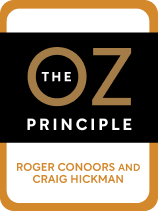

This article is an excerpt from the Shortform book guide to "The Oz Principle" by Roger Connors, Tom Smith, and Craig Hickman. Shortform has the world's best summaries and analyses of books you should be reading.
Like this article? Sign up for a free trial here .
What role does accountability play in team success? What can you, as a leader, do to cultivate accountability at an organizational level?
There are many benefits to cultivating an organizational culture of accountability. At a high level, a culture of organizational accountability reinforces initiative and creativity, contributes to a positive work environment, improves employee performance, and boosts profitability.
This article takes a look at how you can implement a mindset of accountability throughout your organization.
Cultivating Organizational Accountability
While accountability is an individual choice, you can create conditions within your organization that ensure people make that choice:
1. Teach and Train Everyone in Accountability
Training people in accountability involves first unlearning the idea that accountability is simply another form of blame.
Discuss the behaviors of accountable people versus victims. Share personal anecdotes of times you fell into a victim mindset and how you overcame it. Giving concrete examples will help people self-reflect and apply the ideas to their own lives. (Shortform note: Inc. magazine offers the following “8 habits of highly accountable people”: Take responsibility, don’t make excuses, be on time, control our own fate, own your emotions, communicate expectations, collaborate, don’t expect praise—take satisfaction in accomplishment.)
Then, make it clear that accountability is the standard that your team and organization will be held to—incorporate accountability in your expectations and goals.
2. Coach Them Through the Change
Once everyone is on the same page about the meaning of accountability and what accountability looks like, coach them to form good habits around accountability.
(Shortform note: The Gallup organization notes that many companies’ accountability problems may actually be coaching problems. In a Gallup survey, 47% of workers reported receiving feedback “a few times or less” in a year; and only 26% strongly agreed that the feedback they got helped them do better.)
The authors point out that coaching people is different from controlling them. Instead of telling someone what to do, ask them what they think they should do. Give them the opportunity to make decisions and solve problems, because that will help them form good habits around accountability. It also forces them to take responsibility for their own work, rather than only taking orders (thus leaving the responsibility with whoever’s directing them).
(Shortform note: To further clarify the difference between coaching and controlling (or managing), a Forbes article describes coaching as involving exploring, facilitating, partnering, encouraging ongoing improvement, and opening the door to multiple potential outcomes. In contrast, managing involves ordering, directing, meeting immediate needs, and producing a specific outcome. This chart shows additional differences in coaching mindset and behavior.)
A few elements of good coaching include:
Encouraging Two-Way Feedback
Anyone can revert to bad habits. The benefit of a team is that members can look out for each other, providing support, encouragement, and constructive advice to keep moving forward. To facilitate giving and receiving feedback, make sure people feel safe speaking up.
(Shortform note: Ways to ensure that employees feel safe speaking up include proving that you value what people have to say, avoiding making them feel wrong, listening without judgment, and ensuring psychological safety by being open, honest, and respectful.)
Validate those who speak up to offer another perspective: Thank them, acknowledge the value of their input, and engage thoughtfully with their points.
Following Up
Just as you monitor your own progress, keep track of how the people you’re coaching are doing. Set specific times and dates to follow up with them. Make it routine.
But don’t micromanage—be willing to leave people to their own devices, and trust that they’ll figure things out. Knowing when to intervene and when to rely on your team is part of being a good leader. (Shortform note: In contrast, micromanaging not only undermines trust, it’s also highly stressful for employees.)
Getting to the Root of What’s Holding Them Back
When there’s a problem, ask questions and do your own investigating if necessary to find (and guide employees to) the underlying causes.
People might give excuses, misinterpret events, lack information, or otherwise be unable to pinpoint why something went wrong. It’s not that you should distrust what they say; just be aware that people have biases, and you can’t always take someone’s version of events as the absolute truth. Remember, it’s not about blaming them—it’s about giving them the tools to overcome their obstacles.
3. Ask the Right Questions
Next, help your team maintain a positive and productive attitude by asking questions that guide them toward an accountability mindset. For example, you might encourage your team members to respond to all problems with “How can I help?” Or to respond to obstacles with “What’s the next step?” This focuses people’s thinking on making progress and on how they can influence the situation.
However, you might also come up with your own questions tailored to your organization’s unique needs. These questions might draw attention to signs that you’re making errors you’ve made in the past, or the unique goals and results you’re aiming for now. For example, if your team once missed a project deadline because a mathematical error forced you to redo work, you might set checkpoints to ask: “Have we double-checked our calculations so far?”
4. Keep Track of Their Progress
An accountability mindset, or lack thereof, will be evident in people’s work. You’ll know if people are holding themselves accountable by whether they get results, complete tasks on time, and follow through on the things they say they’re going to do.
Help them stay on track by starting small, creating routines, and checking in on their progress. If they have many projects, tasks, or commitments on their plate, get them to focus on one goal at a time. Don’t just wait for them to finish and come to you with an update. Follow up with them at mutually agreed-upon times. If they falter, you can offer constructive feedback. If they’re succeeding, offer encouragement and praise. (Shortform note: Similarly, The Coaching Habit recommends taking advantage of daily coaching opportunities. For example, if an employee sends you a long email about a problem, respond by asking, “Before I send you a detailed reply, can you tell me what the central challenge is for you?”)
You’ll slowly normalize accountability as part of the day-to-day operations within your organization.
5. Reinforce Accountable Behaviors
Once people begin to practice accountability, reinforce those behaviors so that they become habits. For example, use keywords or phrases—like the questions you came up with. Even the word “accountability” can become a signal that reminds people of discussions you’ve had.
Another way to reinforce good habits is to use rewards, especially praise or recognition. (Shortform note: In Carrots and Sticks Don’t Work, Paul Marciano notes that managers tend to overestimate how much recognition they give. But recognition is a key part of a leader’s job, because quick recognition of positive behavior locks in that behavior while failure to reinforce it makes it less likely to be repeated. Further, a minute spent complimenting someone’s work can lead to hours of increased productivity.)
When organizational accountability is a company value, those who show the greatest accountability are entrusted with more responsibility and earn promotions as well. They become leaders, which helps cement a culture of accountability in the organization.

———End of Preview———
Like what you just read? Read the rest of the world's best book summary and analysis of Roger Connors, Tom Smith, and Craig Hickman's "The Oz Principle" at Shortform .
Here's what you'll find in our full The Oz Principle summary :
- Why you have more power to create change than you may realize
- How to stop thinking like a victim
- The four steps to mastering accountability






